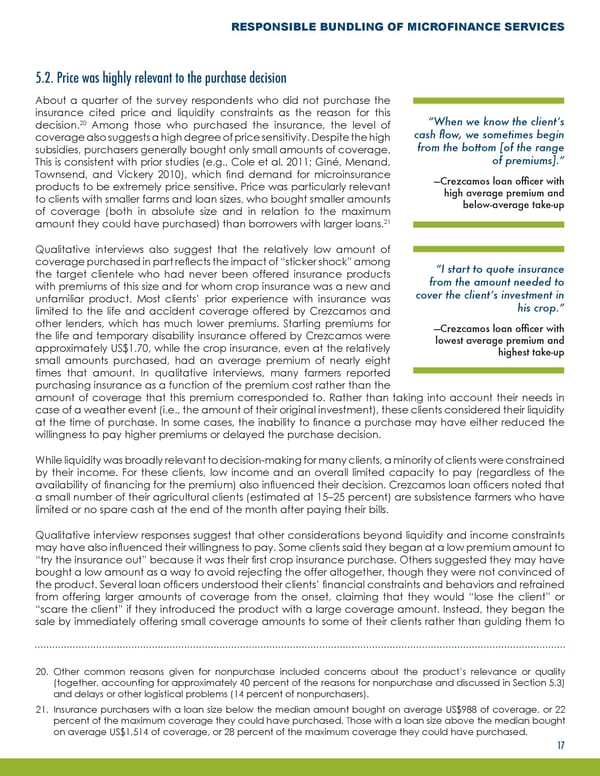RESPONSIBLE BUNDLING OF MICROFINANCE SERVICES 5.2. Price was highly relevant to the purchase decision About a quarter of the survey respondents who did not purchase the insurance cited price and liquidity constraints as the reason for this decision.20 Among those who purchased the insurance, the level of “When we know the client’s coverage also suggests a high degree of price sensitivity. Despite the high cash flow, we sometimes begin subsidies, purchasers generally bought only small amounts of coverage. from the bottom [of the range This is consistent with prior studies (e.g., Cole et al. 2011; Giné, Menand, of premiums].” Townsend, and Vickery 2010), which find demand for microinsurance —Crezcamos loan officer with products to be extremely price sensitive. Price was particularly relevant high average premium and to clients with smaller farms and loan sizes, who bought smaller amounts below-average take-up of coverage (both in absolute size and in relation to the maximum 21 amount they could have purchased) than borrowers with larger loans. Qualitative interviews also suggest that the relatively low amount of coverage purchased in part reflects the impact of “sticker shock” among “I start to quote insurance the target clientele who had never been offered insurance products from the amount needed to with premiums of this size and for whom crop insurance was a new and cover the client’s investment in unfamiliar product. Most clients’ prior experience with insurance was his crop.” limited to the life and accident coverage offered by Crezcamos and other lenders, which has much lower premiums. Starting premiums for —Crezcamos loan officer with the life and temporary disability insurance offered by Crezcamos were lowest average premium and approximately US$1.70, while the crop insurance, even at the relatively highest take-up small amounts purchased, had an average premium of nearly eight times that amount. In qualitative interviews, many farmers reported purchasing insurance as a function of the premium cost rather than the amount of coverage that this premium corresponded to. Rather than taking into account their needs in case of a weather event (i.e., the amount of their original investment), these clients considered their liquidity at the time of purchase. In some cases, the inability to finance a purchase may have either reduced the willingness to pay higher premiums or delayed the purchase decision. While liquidity was broadly relevant to decision-making for many clients, a minority of clients were constrained by their income. For these clients, low income and an overall limited capacity to pay (regardless of the availability of financing for the premium) also influenced their decision. Crezcamos loan officers noted that a small number of their agricultural clients (estimated at 15–25 percent) are subsistence farmers who have limited or no spare cash at the end of the month after paying their bills. Qualitative interview responses suggest that other considerations beyond liquidity and income constraints may have also influenced their willingness to pay. Some clients said they began at a low premium amount to “try the insurance out” because it was their first crop insurance purchase. Others suggested they may have bought a low amount as a way to avoid rejecting the offer altogether, though they were not convinced of clients’ the product. Several loan officers understood their financial constraints and behaviors and refrained from offering larger amounts of coverage from the onset, claiming that they would “lose the client” or “scare the client” if they introduced the product with a large coverage amount. Instead, they began the sale by immediately offering small coverage amounts to some of their clients rather than guiding them to 20. Other common reasons given for nonpurchase included concerns about the product’s relevance or quality (together, accounting for approximately 40 percent of the reasons for nonpurchase and discussed in Section 5.3) and delays or other logistical problems (14 percent of nonpurchasers). 21. Insurance purchasers with a loan size below the median amount bought on average US$988 of coverage, or 22 percent of the maximum coverage they could have purchased. Those with a loan size above the median bought on average US$1,514 of coverage, or 28 percent of the maximum coverage they could have purchased. 17
 Responsible Bundling of Microfinance Services Page 19 Page 21
Responsible Bundling of Microfinance Services Page 19 Page 21